Silver Beach Amusement Park History
 Page 2 of 6 Page 2 of 6 
Click photos below
for expanded views
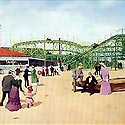
| 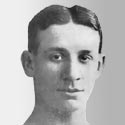
| 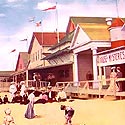
| 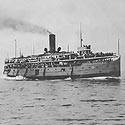
| 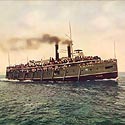
| 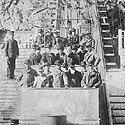
| 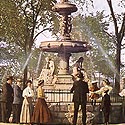
| 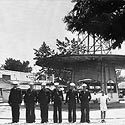
| 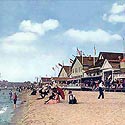
| 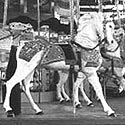
| 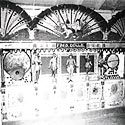
|
The first of the aforementioned three buildings was the bathhouse and swimming pool. Drake wanted to give the park bathers a choice of swimming in the lake or the large indoor pool, an extreme rarity of its time. The pool used lake water that was heated by a steam furnace. Large skylights let sun in for additional heat and light. The bathhouse, or Natorium, built about 1904, was 210 x 70 feet and 24 feet tall, and was constructed for approximately $3,000. Early twentieth century swimmers could rent an entire swimming outfit, "complete with stockings, bloomers and blouse, along with matching hat and umbrella."1 Lockers for women were upstairs, men's lockers were downstairs, and both offered full bathing suits and towels for rent. Lock boxes were issued with pin-on keys for securing valuables. "Water wings" were also on hand for non-swimmers.2
In 1904-5, the "Chase through the Clouds", or, more informally, the "Figure 8" rollercoaster was built. It was Logan Drake's crowning achievement to that point. The park's first rollercoaster however, was not at all like those monsters of amusement parks today. It was not linked like a snake, but utilized several separate one or two-person capacity cars.3 The speeds attained on the track were less than half of those obtained on similar rides today, and the track was shorter and less dangerous looking. But the ride was unique in the area and it caught on fast. And it was safe too. Everyday the operator inspected the entire track; while every spring, before any paying customers were allowed to ride, the park owners and some of the employees took the season's first test trips.4 The "Figure 8" was a staple of the amusement park until it was torn down in 1923, to make way for the "Velvet" rollercoaster.
In 1905, the second building erected by the Silver Beach Amusement and Realty Company was an open-ended roller skating rink north of the Natorium. The rink was thought to be the first in the area. Roller skates as they exist today were unheard of, and the rented skates were attached to the shoes with leather straps. In 1906 Louis Wallace added southwestern Michigan's first pipe organ to the rink.5 The wooden rink enjoyed great success as the local newspaper noted that the rink was often "crowded with enthusiastic skaters."
In the summer of 1905, Boxing matches were held at the Silver Beach Amusement Park, pitting some of the best fighters of the Midwest against each other. Tommy Ryan (Ryan, considered by many as the best Middleweight ever, was a smart, good boxer and a hard-hitter. Ryan worked with many fighters to improve their technique. Ryan was elected to the Ring Boxing Hall of Fame in 1958.), who had been a middleweight champion and is now a member of the Boxing Hall of Fame, organized the pugilist matches. These Boxing exhibitions were extremely popular, sometimes drawing crowds of over 3,000, but were discontinued when St. Joseph city officials deemed the matches too brutal.
Around the turn of the century there was a pressing need for a big dance hall in the twin city area of St. Joseph and Benton Harbor. Drake and Wallace capitalized on this need and in 1906-7 constructed a dance pavilion & casino at the south end of their land. The hall featured two stages for the bands, one at the rear and one on the side of the building. With this setup the "battle of the bands" grew popular in the pavilion. Drake later added an ice cream parlor inside the building.6
These activities, along with the penny arcade and concession stands, drew huge crowds of tourists from Michigan as well as those from Illinois and Wisconsin. Drake and Wallace responded by adding the "House of Mysteries" amusement a forerunner of a modern spookhouse or mirror maze, in 1907.
The Silver Beach Amusement Park grew in popularity. Although many factors contributed to the park's early success, none were ever more important than lake transportation. The park's ideal location at the mouth of the St. Joseph River on Lake Michigan gave tourists an eyeful of fun before they even stepped off the boats. Located in the Twin Cities was the famous Graham and Morton boat line, with passenger and freight ships making daily runs to Chicago and Milwaukee. Shipping was a profitable business as well as the best means of long-distance transportation. The G & M line offered several fine upper cabin propeller steamers, which contributed greatly to the success of Silver Beach Amusement Park. Two of these were named "City of Benton Harbor" and "City of Chicago". The crossing took about 5 hours bringing thousands of tourists to St. Joseph and Benton Harbor. It was possible for Chicago citizens to leave on the morning boats, spend a day at Silver Beach Amusement Park, and return on the evening boats or stay the night in one of the many nearby hotels. A moving stairway was installed to carry people from the foot of the bluff at Vine Street to Lake Boulevard where some early hotels were located and where the Maids of the Mist fountain at the Whitcomb tower stands today.
While the boats continuously brought in more and more visitors, the Silver Beach Amusement Company had to supply their new arrivals with more things to do. Around 1910 Drake established the "dog-ride" where children sat in miniature carriages or Conestoga wagons and were pulled around a turnstile by a team of dogs.7
For the adults, Drake and Wallace added a variety of amusements. An airplane ride, in honor of the first American airplane flight on Silver Beach in 1898, was established behind their buildings about a hundred yards from the lake. The ride consisted of six airplanes of pre-World War I design suspended on steel cables from a motorized revolving top. Drake also added an enclosed picnic area for those who wished to bring a sack lunch or basket to the park.
The beachside park was very popular by now. So popular that a 1913 postcard of an artist's "birds eye view" of the area shows several small private souvenir or refreshment stands strung along a half-mile stretch on the banks of the St. Joseph River.8 Patrons would walk along the river and concessions on their way to the lake.
During the pre-war years the lake began doing something strange. The waters of Lake Michigan were constantly pushing up more and more sand each season, making a much larger beach. When the Silver Beach Amusement Company began building in 1902 the waves would flow up to the boardwalk, but in the next two decades more than fifty yards would separate the two.
With the extra beachland caused by the vanishing waters, another attraction was added.9 The merry-go-round carousel was catching on fast in Europe during the early twentieth century and when it first appeared in St. Joseph it proved to be an instant success. The merry-go-round carousel and organ imported from Germany, with hand carved horses wearing jeweled saddles and real horsehair tails was operating at the Silver Beach Amusement Park by 1916. Famous merry-go-round carousel builder Fred Dolle of North Bergen, NJ constructed the ride using horses carved by Charles Carmel of Brooklyn, NY. Dolle operated the merry-go-round carousel at Silver Beach until 1930 when Logan Drake bought the ride outright.
The merry-go-round carousel had 3 rows consisting of 44 horses. Originally, there were no jumping horses. But, in the 1920's it was sent back to the factory and 16 jumpers were placed on the machine. The original standers that were replaced were returned with the machine (later stacked up and burned in 1948). M.D. Borelli and his wife, also a builder of merry-go-round carousels, added the jewels to the horses in 1924.
Although the horses were the chief asset of the ride, most of the children wanted to know where the beautiful music came from. The carousel organ was enormous to the eyes of a child. It stood 8' x 8' and was stationed above the motor pit in the center of the huge ride. At the top was a fascinating ornamental predicament that pictured a figure of a reclining Italian woman, while below her on a stage were several smaller figures, each about two-feet high that danced when the organ played.
The entirely handcarved organ delighted children with its gay music until the mid-1930s when it was replaced by two Wurlitzer organs. The massive although mute structure remained with the park as a decoration until the park's final days in 1971. A unique feature of the merry-go-round carousel was the elusive gold ring. The ring dangled from a post outside the circumference of the ride and any youngster skillful enough to snatch it would receive a free ride.10
The Benton Harbor News Palladium noted, "the people who flock to the park on weekends via the riverboats and barges love the gay music and ponies that move."11
Page 2 of 6
1 | 3 | 4 | 5 | 6
Do you have any Silver Beach
Amusement Park photos, movies
or artifacts you'd like to share?
Please contact us.
1 Benton Harbor News Palladium, July 26, 1965. [ Back ] 2 Interview with John Wenzlaff, February 1976. [ Back ] 3 Interview with Roberta Drake Terrill, January 1976. [ Back ] 4 Interview with John Wenzlaff, March 1976. [ Back ] 5 Benton Harbor News Palladium, Wallace obituary, July 6, 1945. [ Back ] 6 Interview with Roberta Drake Terrill, January 1976. [ Back ] 7 Interview with Dudley Wallace, February 1976. [ Back ] 8 Postcard belonging to John Wenzlaff. [ Back ] 9 Benton Harbor News Palladium, August 28, 1957. [ Back ] 10 Interview with Larry Rose, March 1976. [ Back ] 11 Benton Harbor News Palladium, August 28, 1957. [ Back ]
We credit Alan Schultz, Jeff Terrill, John Wenzlaff & Michigan History Magazine for the materials necessary to create this chapter in SW Michigan History.
To subscribe, click Michigan History Magazine.
|